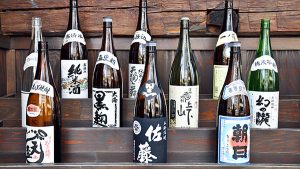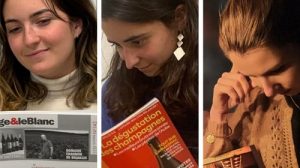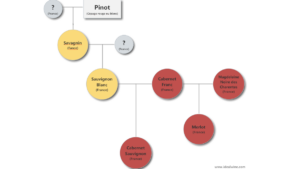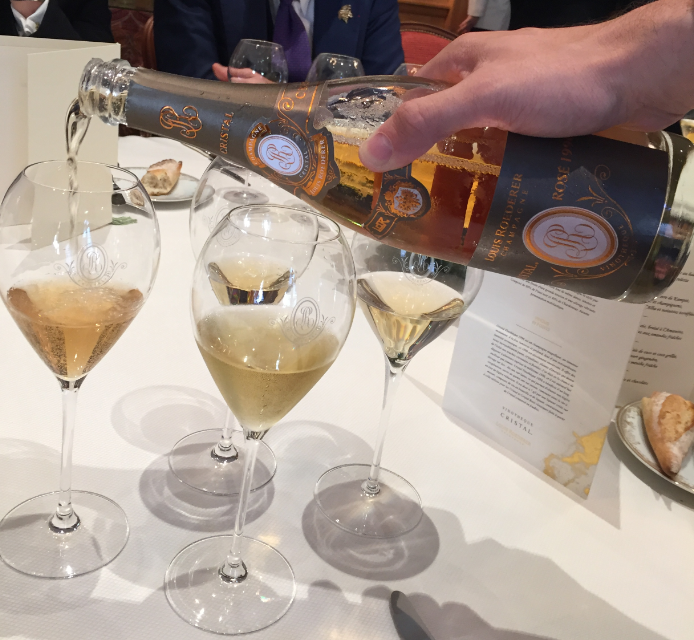
Some moments leave an indelible mark on a wine lover’s memory. Tasting the cuvée Cristal 1996, in its Vinothèque version, in both the white and rosé, was one such moment. Let me tell you all about it!
If you’re asking yourself what exactly this cuvée Cristal Vinothèque is, it means you don’t read the iDealwine blog quite often enough 😉. This cuvée is the fruit of Jean-Baptiste Lécaillon’s (Roederer’s cellar master) limitless imagination, and the first of these was unveiled last year with the Cristal Vinothèque 1995. Today, we’re trying the 1996!
Autumn flowers welcome us as we arrive at the Hotel Bristol
Biodynamic, family-based viticulture
Who doesn’t know the exceptional cuvée Cristal, produced from a vineyard of 45 parcels, from a chalky soil that is cultivated like a garden, and is today entirely converted to biodynamic farming? Jean-Baptiste is progressively spreading this, his own philosophy, to the rest of the house’s vineyards: both the cuvée Blanc de Blancs and Brut Nature have been converted. The viticulture at Roederer is family-based, traditional and respectful of the soils (which are tilled, on some parcels by horse, in order to preserve the most fragile rootstocks).
The original idea, which preceded the Vinothèque experience, is essentially that the cuvée Cristal was always released to wine lovers and put on the market far, far too early. At 10 years old, it’s still a ‘new-born’, in Jean-Baptiste Lécaillon’s words, and needs much more time to age in the silence and comfort of the house’s cellars.
The idea was thus to set aside some of the wines, to prolong their stay in the cellar to allow them to develop and nurture a Cristal which was even more mature, without of course betraying its identity, that is, a cuvée in which freshness, precision and elegance meld together.
Cristal Vinothèque 1996
1996? That was a difficult vintage. It should have, however, been exceptional. There’s no doubt it was harvested a little too early, it has high acidity, and needed a lot of time to find the right balance. The wine was therefore raised for ten years on its lees, before spending four years without the lees to avoid the risk of oxidization. The wines are then disgorged. The dosage is minimal, 6-7 grams. The wines then spend 7 years in the cellar before resurfacing… and here they are.
hen tasting, it’s the concentration that stands out first. This champagne, which combines immense tension with astounding freshness, lifted by its aromas of lemon zest and minerality which owes a lot to the white soils from which it’s produced. He acidity is of course present, but it also has an excellent, well-rounded balance, even some vanilla notes. This vintage is today perfectly ready. This vibrant Cristal was the sublime pairing to the intense flavours of the Alba truffles in a magnificent dish of wild turbot with chestnut confit and wild mushrooms.
Cristal Vinothèque 1996 rosé
In the rosé version, Cristal Vinothèque is highly emotional wine. The profile of this rosé is completely different compared with that of the white. Where the white was sharp and precise, the rosé is suave on the palate, delicate and velvety, compensating for the strong acidity of this vintage. Its velvety, enveloping texture is a voluptuous accompaniment to the veal braised in Amaretto, delicately caramelized…
This lunch was also the perfect opportunity to taste and rediscover two of the cuvée’s recent successes.
Cristal 2008
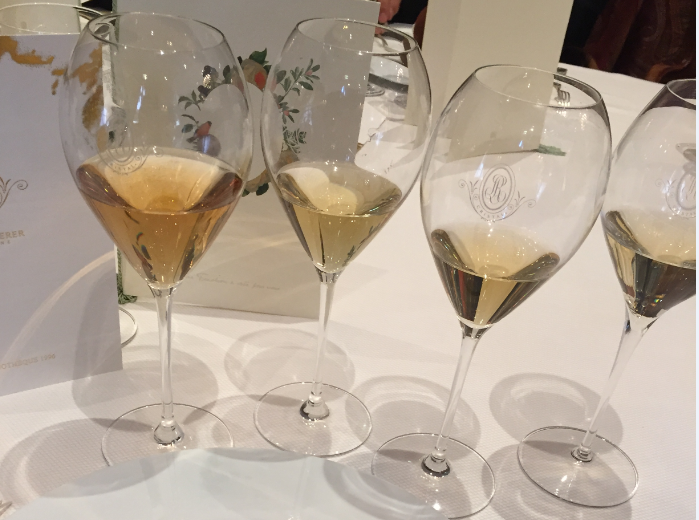
Purity, freshness, elegance: Roederer’s cuvée Cristal
This cuvée is too young after 10 years to drink, that’s what we just established, isn’t it? We start with Cristal 2008, which is a true treasure. It sparkles with purity. However, 2008 wasn’t an east vintage to vinify, it also needed meticulous care and attention. Vinified partially under oak (20%), to gain in sweetness and concentration, it spent 8 years on lees. The long élevage has lent this wine a lovely substance, roundness and a long finish. There again, the minerality so typical of chalky soils is very present. The result is quite simply brilliant: this wine is to be enjoyed now, or to be aged for another 10 years or so…
Cristal 2002
This vintage was a dream, according to Jean-Baptiste, who would have liked to vinify this year again and again, it was so perfect. What’s more, while usually only the best Pinot and Chardonnay go into this cuvée, in 2002, no selection was made, and the entire harvest was used! 2002 was the year in which the house stopped using pesticides, and begun reviving the soils in their first steps towards biodynamic conversion. The hot, dry summer made for concentrated grapes, and the harvests came one week early. When tasting, Cristal 2002 has considerably changed in one year, gaining in depth and complexity, and in fullness too. It has, however, retained its aromatic freshness, its concentration and nice saline notes in the finish.
It’s an honour to taste these cuvées, the product of such an exceptional level of exigence, precision, and risk-taking. Every one of them deserve only the best food pairings to elevate them. Eric Fréchon, an artist at work, majestically rose to the challenge. Bernard Neveu, head sommelier, has not been left behind, having built “the best wine list in the world” (the title granted by Wine Spectator), he assures that the food and wine pairings are simply… perfect. They each contribute to timeless, unforgettable moments.
Frédéric Rouzaud and the Roederer house made this experience possible, giving Jean-Baptiste the time to bring his dream to life. Excellent work from an excellent artist!
See all Roederer wines currently for sale
Other things to read on the iDealwine blog:
Champagne Roederer: exceptional tasting discovering the Cristal Vinothèque

